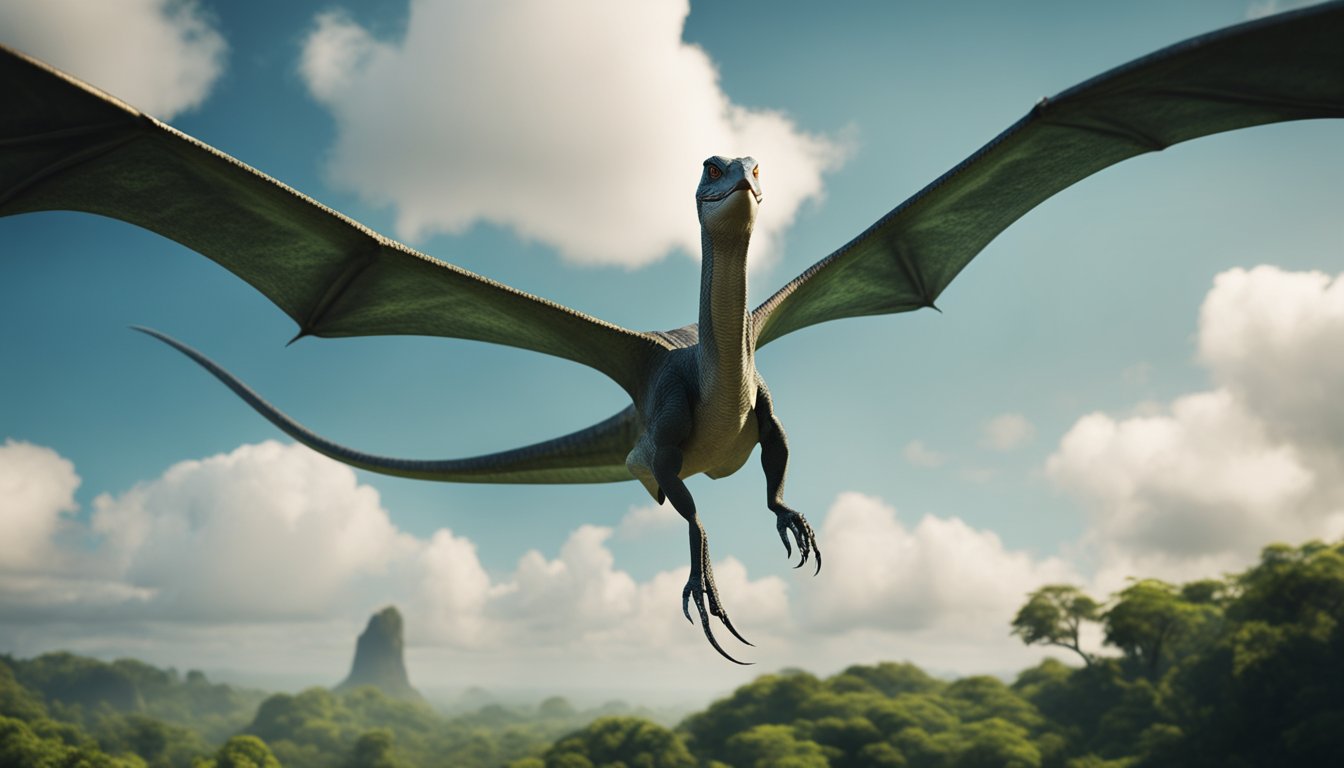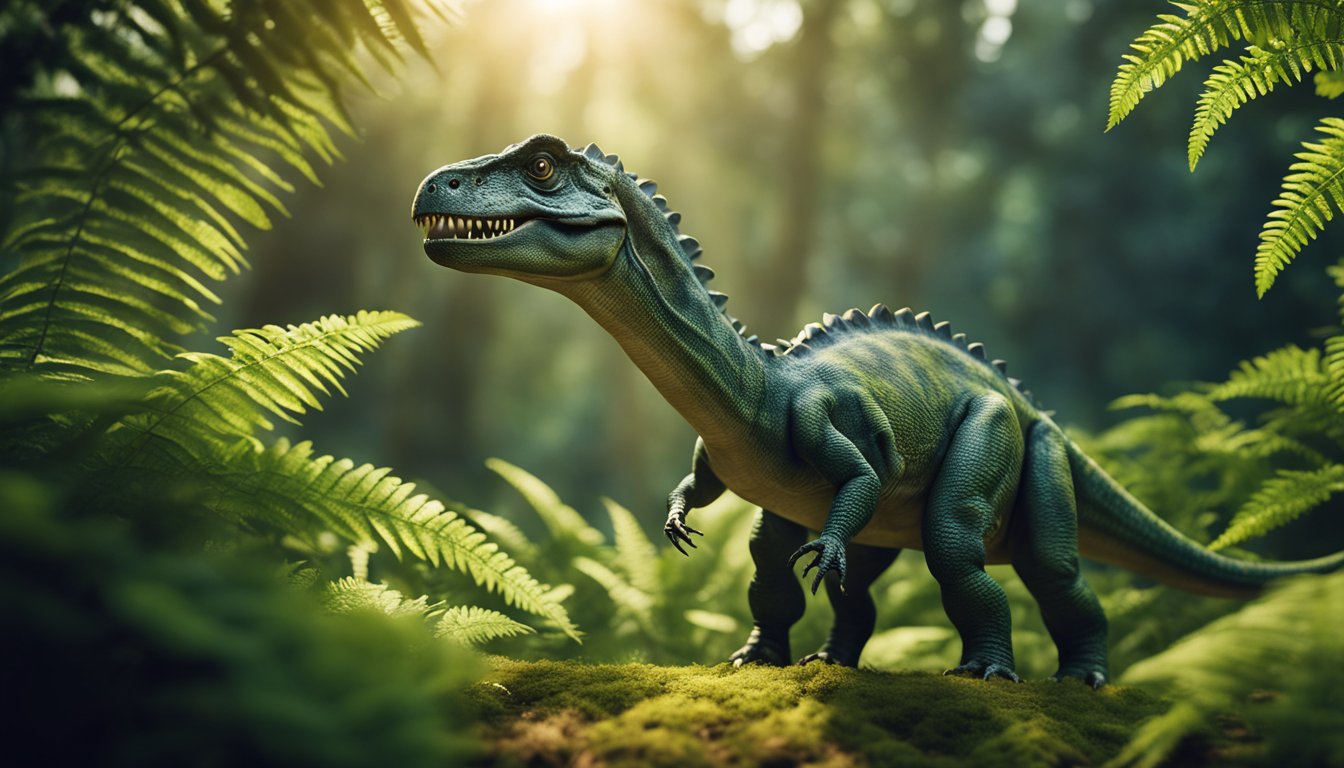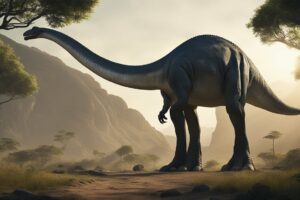Dimorphodon, a prehistoric pterosaur that lived during the Jurassic Period, is one of the most fascinating creatures that ever took to the skies.
With a wingspan of over four feet and a unique tooth structure, this flying reptile was a formidable predator in its time.
Today, scientists study its fossils to learn more about the evolution of flight and the diversity of life that existed millions of years ago.

Pterosaurs, also known as “winged lizards,” were a group of reptiles that lived alongside dinosaurs during the Mesozoic Era.
Dimorphodon was one of the earliest pterosaurs, and its fossils have been found in England, Germany, and Argentina.
Despite its relatively small size, it was an agile flyer and may have preyed on small animals like insects and lizards.
Its distinctive teeth, which were different lengths, suggest that it had a specialized diet.
Studying Dimorphodon and other prehistoric pterosaurs can help us understand the history of flight and the adaptations that enabled these creatures to take to the skies.
By examining their bones and comparing them to modern birds and bats, scientists can piece together the evolutionary history of flight and learn more about the diversity of life that existed during the age of the dinosaurs.
Unveiling the Dimorphodon

Dimorphodon is a prehistoric pterosaur that lived during the early Jurassic period, about 175 to 160 million years ago.
It was first discovered by Mary Anning, a famous fossil hunter from England, in the early 1800s.
Since then, several Dimorphodon fossils have been found in England, Germany, and France.
Fossil Discoveries
Dimorphodon fossils are relatively rare, but they have provided valuable insights into the anatomy and behavior of these ancient flying reptiles.
Most of the fossils discovered so far include skull fragments, teeth, and parts of the wings and tail.
Physical Characteristics
Dimorphodon had a unique appearance that set it apart from other pterosaurs.
It had a large head with deep, wide, toothed jaws resembling the beak of the modern-day puffin.
Its neck was short, and its body was relatively small, measuring about 1 meter in length.
Wings and Flight
Dimorphodon had a wingspan of about 4 feet, which is relatively small compared to other pterosaurs.
Its wings were made of a thin, leathery membrane that stretched between its elongated fourth finger and its body.
Dimorphodon was not a strong flier and probably spent most of its time gliding over the water, looking for fish to eat.
Despite its small wingspan, Dimorphodon was still able to fly thanks to its unique wing structure.
Its wings were shaped like an airplane wing, with a curved upper surface and a flat lower surface.
This allowed Dimorphodon to generate lift and stay in the air for extended periods.
Dimorphodon’s tail was also an important part of its flight system.
It had a long, stiff tail that helped it to steer and maintain balance in the air.
In conclusion, Dimorphodon was a fascinating prehistoric creature that played an important role in the evolution of flying animals.
Its unique anatomy and flight system have provided valuable insights into the natural world, inspiring scientists and amateur paleontologists alike to continue exploring the skies with a sense of wonder and curiosity.
The Life of a Flying Reptile

Dimorphodon was a prehistoric pterosaur that lived during the early Jurassic period, some 200 million years ago.
These flying reptiles were known for their unique appearance and their ability to soar high above the ground.
Diet and Feeding Habits
Dimorphodon was a carnivore that fed on a variety of prey, including insects and fish. Its diet consisted of small animals that it caught while flying.
It had a long beak with sharp teeth that allowed it to easily catch and eat its prey.
Habitat and Distribution
Dimorphodon lived in Europe, specifically in coastal regions. It preferred to live near the coast, where it could easily find food and water.
It was one of the most common pterosaurs found in England, where it was first discovered in 1828 by Mary Anning.
Behavior and Lifestyle
Dimorphodon was a social animal that lived in groups. It was also known for its unique flying abilities, which allowed it to soar high above the ground.
It was not a strong flier compared to later pterosaurs like Pteranodon, and tended to clamber about on four legs.
Pterosaurs were a diverse group of reptiles that lived during the Mesozoic Era.
They were the first vertebrates to evolve powered flight, and they had a wide range of sizes and shapes.
Some pterosaurs were as small as sparrows, while others had wingspans of up to 33 feet.
Flying reptiles like Dimorphodon were an important part of the ecosystem during the Jurassic period.
They played an important role in controlling insect populations and were a food source for larger predators.
In conclusion, Dimorphodon was a fascinating prehistoric creature that played an important role in the ecosystem during the Jurassic period.
Its unique appearance and flying abilities make it an interesting subject for study and exploration.
Dimorphodon Through the Ages
Evolution and Relatives
Dimorphodon is a prehistoric pterosaur that lived during the Jurassic period, approximately 175 to 160 million years ago.
It was named by Richard Owen in 1859 and was one of the first pterosaurs to be discovered.
The name “Dimorphodon” means “two-formed tooth,” referring to its two different types of teeth.
Dimorphodon belongs to a group of prehistoric flying reptiles called pterosaurs.
Pterosaurs were not dinosaurs, but they lived at the same time as dinosaurs.
They were the first vertebrates to evolve powered flight, and they ranged in size from small creatures the size of sparrows to giants with wingspans of up to 33 feet.
Dimorphodon was a medium-sized pterosaur, with a wingspan of around 4.5 feet.
Dimorphodon is closely related to other Jurassic pterosaurs such as Rhamphorhynchus and Pterodactylus.
Rhamphorhynchus had a long tail that ended in a diamond-shaped rudder, while Pterodactylus had a shorter tail and a larger head.
Dimorphodon in Popular Culture
Dimorphodon has appeared in several works of popular culture, including the Jurassic Park franchise.
In the movie Jurassic World, Dimorphodon is depicted as a dangerous predator that can fly at high speeds and attack humans.
Dimorphodon has also appeared in literature, such as the children’s book “The Dinosaurs of Waterhouse Hawkins” by Barbara Kerley.
The book tells the story of Victorian artist Waterhouse Hawkins, who created life-size models of prehistoric animals for the Crystal Palace in London.
Dimorphodon is one of the animals that Hawkins creates, and the book describes how he researched the animal’s anatomy and behavior to make his model as accurate as possible.
Cultural Significance
Dimorphodon and other pterosaurs have captured the imaginations of people for centuries. They are fascinating creatures that inspire awe and wonder.
Pterosaurs were the first animals to evolve powered flight, and their wings were made of a thin, lightweight membrane that stretched between their fingers.
Dimorphodon and other pterosaurs are important because they help us understand the evolution of flight.
By studying their anatomy and behavior, scientists can learn more about how animals first took to the skies.
Fun fact: Did you know that pterosaurs were not dinosaurs? They were actually a separate group of reptiles that evolved alongside the dinosaurs.
Frequently Asked Questions

What did Dimorphodon eat during its time on Earth?
Dimorphodon was a carnivorous pterosaur, which means it ate meat. Specifically, it likely fed on small fish, insects, and other small animals.
Dimorphodon had sharp teeth that were perfect for catching and tearing apart its prey.
How large could a Dimorphodon get, and what was its wingspan?
Dimorphodon was a relatively small pterosaur, with an estimated wingspan of around 1.5 meters (5 feet).
It weighed about 2.5 kilograms (5.5 pounds), which is about the same as a small house cat.
Where have scientists found Dimorphodon fossils?
Dimorphodon fossils have been found in England, specifically in the limestone cliffs of Lyme Regis in Dorset.
These cliffs are known for their abundance of fossils from the Jurassic period, including many other types of pterosaurs and dinosaurs.
Can you describe the habitat where Dimorphodon once lived?
During the Jurassic period, when Dimorphodon lived, the Earth was very different than it is today.
The climate was warmer and wetter, and there were vast swamps and forests.
Dimorphodon likely lived near the coast, where it could easily catch fish and other prey.
What adaptations helped Dimorphodon survive in its environment?
Dimorphodon had several adaptations that helped it survive in its environment.
Its wings allowed it to fly, and its sharp teeth were perfect for catching and tearing apart its prey.
It also had a long tail that helped it balance in the air.
Additionally, scientists believe that it was warm-blooded, which would have allowed it to regulate its body temperature and stay active in cooler temperatures.
Which predators posed a threat to the Dimorphodon in its era?
During the Jurassic period, Dimorphodon likely had to contend with several predators, including other pterosaurs and small carnivorous dinosaurs.
However, it is also possible that Dimorphodon was a predator itself, and may have even hunted other pterosaurs and small dinosaurs.






